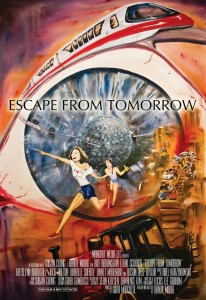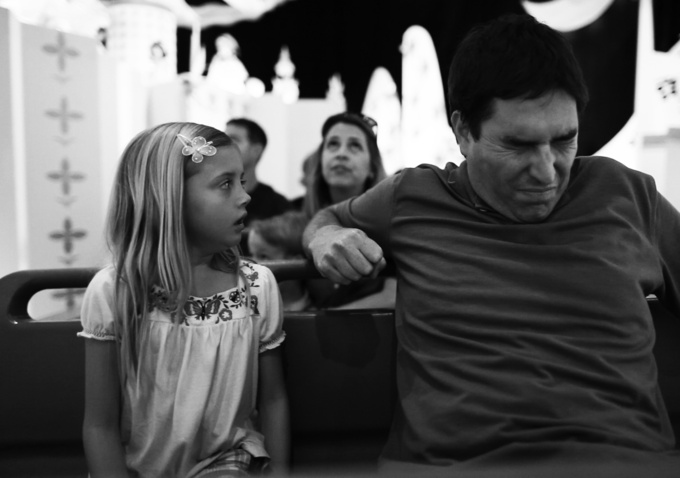As of this Monday morning the Sundance Film Festival still has nearly a week left to go, and yet I think we already know what will end up being the most intriguing story out of Park City, Utah this year. It’s a small film, an apparently bizarre film, and a film with a truly unique, truly awesome story, and it’s called Escape From Tomorrow.
You’re also going to be told several dozen times that you’ll never, ever, EVER EVER see it.
While that is probably the opposite of true, the fun part of all this is that it is a movie that innately challenges the authority of perhaps the mightiest media conglomerate on the planet… Disney.
You see, Escape From Tomorrow is a film that was shot almost entirely on Disney property, as filmmaker Randy Moore brought his cast, Canon camera, and tiny crew into Disneyland in Anaheim and Walt Disney World in Orlando repeatedly to make an unauthorized film about a man losing his mind during his Disney vacation. A surreal, sometimes Lynchian B&W neo-noir, the film apparently “basks” in the scenery of the Disney parks and makes full use of characters and imagery from the  park. Sequences take place on rides likes Space Mountain and Buzz Lightyear’s Space Ranger Spin, while Disney princesses are revealed to be high-priced hookers. While a very small portion of the film was created with plates and greenscreen work, the vast majority of Escape From Tomorrow represents an astounding effort of corporate subversion and clever guerrilla filmmaking.
park. Sequences take place on rides likes Space Mountain and Buzz Lightyear’s Space Ranger Spin, while Disney princesses are revealed to be high-priced hookers. While a very small portion of the film was created with plates and greenscreen work, the vast majority of Escape From Tomorrow represents an astounding effort of corporate subversion and clever guerrilla filmmaking.
According to Moore, they were never bothered.
Though some tricks and tradcraft were certainly employed –the project was a closely guarded secret from anyone not directly involved, and the crew would often disperse and choreograph by the same cellphones on which they read their scripts– the production went unmolested all through post-production, which Moore even took out of the country!
“The filmmaker strongly encouraged anyone who worked on the film not to tell anyone, not even close friends, what they were working on. He was so nervous about a potential blabbermouth at a postproduction house that he took the movie to South Korea to edit, where he has been traveling to, on and off, from Los Angeles for the last two years.” [LA Times]
What is most remarkable is that, apparently, the film manages to be quite cinematic and deliberate despite its clandestine production. The briefest taste of that is available through the clip embedded below. As described in (Disney park enthusiast) Peter Scirreta’s /Film review of the film, the techniques and planning involved were quite sophisticated:
The cinematographer and AD conducted intensive location scouting, with every shot exhaustively planned and blocked in advance. They even charted the position of the sun weeks in advance for each shot of the movie to make up for the lack of lighting equipment. Sound was recorded without an on-set sound mixer, sometimes using smart phones, and sometimes using digital recorders taped to each actor, which would record an entire day’s worth of audio, which editors had to sort through afterward…
…Golden Globe nominated composer Abel Korzeniowski (A Single Man) recorded music for the film on the Eastwood stage of the Warner Bros lot. Visual effects were completed by the same company in South Korea that worked on The Host. Green screen and set production took place at the same movie stages used by Cecil B de Mille and DW Griffith.
More importantly, Escape From Tomorrow is said to be thoroughly worthwhile and interesting, unique context notwithstanding. Though its plot and tone are impossible to divorce entirely from the context of its production, the film is apparently a unique look at the bizzare, plastic nature of the Disney uinverse, an examination of its never-ending joy. It’s not difficult to imagine the Lynchian tone that comes from actors that are both reacting to bizarre occurrences and things seemingly unseen by everyone else, but meanwhile playing it cool lest they get discovered and thrown out!
Having just taken what was effectively my first trip to Disney World and experiencing the self-contained little universe for myself, it’s not hard at all to imagine a film playing around with that ecosystem of plastic optimism. There’s a sense of history and permanence and happy isolation to the parks, created by the sheer volume of costumes and decorations, along with the oddly distorted scale at which the whole grand simulacra is constructed. The mystique of Walt Disney himself and the allure of insider lore (hidden mickeys!) all contribute to something odd and unique. Even Baudrillard, the philosopher responsible for the idea of the “desert of the real,” opined on the idea of Disney parks as a bizarre social construct.
The imaginary of Disneyland is neither true nor false, it is a deterrence machine set up in order to rejuvenate the fiction of the real in the opposite camp. Whence the debility of this imaginary, its infantile degeneration. This world wants to be childish in order to make us believe that the adults are elsewhere, in the “real” world, and to conceal the fact that true childishness is everywhere – that it is that of the adults themselves who come here to act the child in order to foster illusions as to their real childishness.
Subverting the inherent nature of the parks, twisting familiar imagery, re-contextualizing the family vacation experience as something nightmarish… these are not things that Disney as a company is likely to be interested in, and may very well act to suppress.
Naturally, that’s all only going to make most film geeks all the more desperate to see it. The demand will only rise if the next few screenings at the festival result in praise as effusive as is already out there.
ESCAPE FROM TOMORROW is a fascinating, surreal indictment of Disneyfied society that Disney will never, ever let you see. #Sundance13
— erickohn (@erickohn) January 19, 2013
‘Escape from Tomorrow” insane on so many levels. Never seen anything like it. Wally World has nothing on the real thing. #Sundance13
— Scott Macaulay (@FilmmakerMag) January 19, 2013
Escape from Tomorrow: an honest-to-God brain-melter; Polanski’s idea of the family vacation from Hell. Your mileage may vary. #Sundance
— William Goss (@williambgoss) January 19, 2013
Escape from Tomorrow, a b+w surrealist movie shot guerilla-style at Disney parks, may be one of the strangest films ever to play #Sundance.
— Steven Zeitchik (@ZeitchikLAT) January 19, 2013
ESCAPE FROM TOMORROW: WOW! Surreal, funny, ballsy, deep, daring. Film of the Fest? Maybe. #sundance
— Devin Faraci (@devincf) January 21, 2013
Disney should go balls out and pick up “Escape from Tomorrow.”
— Kristopher Tapley (@kristapley) January 20, 2013
It is like nothing I’ve ever seen. Absolute stone cold madness.
— Drew McWeeny (@DrewAtHitFix) January 19, 2013
For his part, Moore is happy the film is merely finished, and seems to have no real expectations of distribution. Don’t count it out entirely though; the production does have a unique asset in its corner in Cinetic Media. A company that specializes in advising unique film productions for sale, they’ve helped sell films like Exit Through The Gift Shop, Precious, The Imaginarium Of Doctor Parnassus, even off-beat hits and major Oscar contenders like Napoleon Dynamite and Little Miss Sunshine.
 Will that be enough to get it in theaters? Likely not. It’s true that few if any distributors are going to even consider touching this with a ten-foot pole. Even if they had absolutely no legal grounds to stand on whatsoever (and they do), Disney could still quash the release of this film with what amounts to a pinky twitch, by the mere act of introducing any litigation against it. A mere sneeze from the Mouse House would be enough to gum up the financial life of a tiny film like this. While the doc Room 237 was more clearly a case of educational fair-use, that film too was characterized as an impossible sell for its use of footage from Kubrick films. That doc has since traveled a seemingly unremarkable path toward sale and an upcoming theatrical release. Few of us are lawyers and Disney has kept quiet thus far, so really the path is murky.
Will that be enough to get it in theaters? Likely not. It’s true that few if any distributors are going to even consider touching this with a ten-foot pole. Even if they had absolutely no legal grounds to stand on whatsoever (and they do), Disney could still quash the release of this film with what amounts to a pinky twitch, by the mere act of introducing any litigation against it. A mere sneeze from the Mouse House would be enough to gum up the financial life of a tiny film like this. While the doc Room 237 was more clearly a case of educational fair-use, that film too was characterized as an impossible sell for its use of footage from Kubrick films. That doc has since traveled a seemingly unremarkable path toward sale and an upcoming theatrical release. Few of us are lawyers and Disney has kept quiet thus far, so really the path is murky.
Fortunately we live in crazy future times where innovative artists can find ways to serve niche audiences or, at the very least, irrevocably put their work out there for consumption, if not profit. We’ll just have to wait and see what path awaits Escape From Tomorrow. All I know is that I must see it.
If you want to learn more about Escape From Tomorrow, check out the full LA Times profile of Moore and his film. I’d also point to Drew McWeeney’s flabbergasted review, the review at Indiewire, and an interesting look at it on Roger Ebert’s blog. Also be sure to watch the clip below, even if it does keep the film’s cards close to the chest, so to speak.
